Microsoft Azure Administrator v1.0
Question 1
You have an Azure subscription named Subscription1 and an on-premises deployment of Microsoft System Center Service Manager.
Subscription1 contains a virtual machine named VM1.
You need to ensure that an alert is set in Service Manager when the amount of available memory on VM1 is below 10 percent.
What should you do first?
- A. Create a notification.
- B. Create an automation runbook.
- C. Deploy the IT Service Management Connector (ITSM).
- D. Deploy a function app.
Answer : C
Explanation:
The IT Service Management Connector (ITSMC) allows you to connect Azure and a supported IT Service Management (ITSM) product/service, such as the
Microsoft System Center Service Manager.
With ITSMC, you can create work items in ITSM tool, based on your Azure alerts (metric alerts, Activity Log alerts and Log Analytics alerts).
References:
https://docs.microsoft.com/en-us/azure/azure-monitor/platform/itsmc-overview
Question 2
HOTSPOT -
You have a pay-as-you-go Azure subscription that contains the virtual machines shown in the following table.

You create the budget shown in the following exhibit.
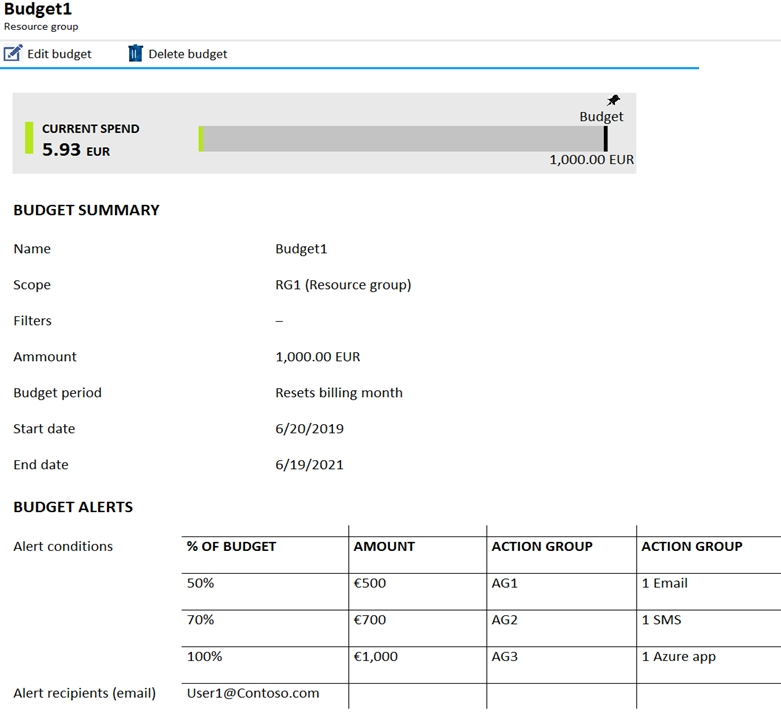
The AG1 action group contains a user named [email protected] only.
Use the drop-down menus to select the answer choice that completes each statement based on the information presented in the graphic.
NOTE: Each correct selection is worth one point.
Hot Area:
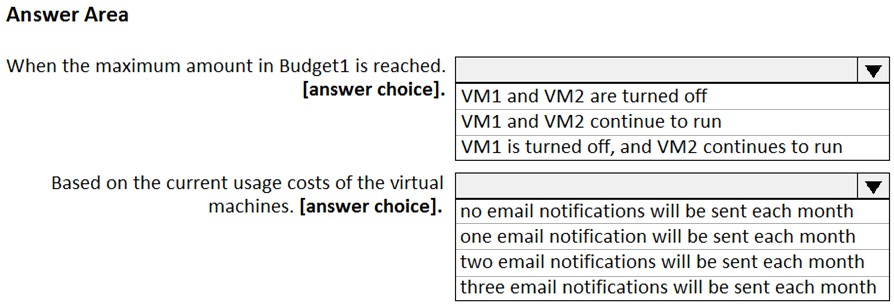
Answer : 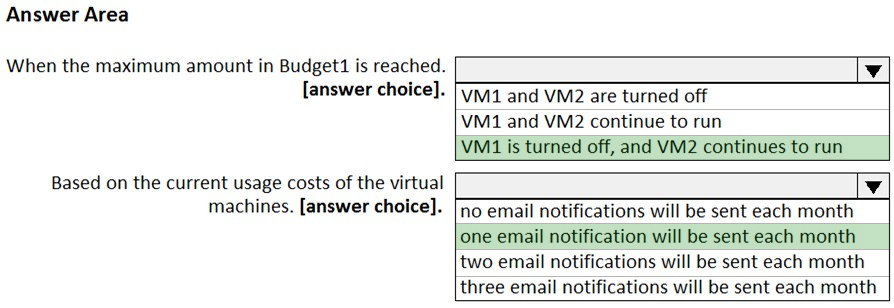
Explanation:
Box 1: VM1 is turned off, and VM2 continues to run
The budget alerts are for Resource Group RG1, which include VM1, but not VM2.
Box 2: one email notification will be sent each month.
Budget alerts for Resource Group RG1, which include VM1, but not VM2.VM1 consumes 20 Euro/day. The 50% ,500 Euro limit, will be reached in 25 days, and an email will be sent.
The 70% and 100% alert conditions will not be reached within a month, and they don't trigger email actions anyway.
Credit alerts: Credit alerts are generated automatically at 90% and at 100% of your Azure credit balance. Whenever an alert is generated, it's reflected in cost alerts and in the email sent to the account owners. 90% and 100% will not be reached though.
References:
https://docs.microsoft.com/en-us/azure/cost-management-billing/costs/cost-mgt-alerts-monitor-usage-spending
Question 3
You have an Azure Active Directory (Azure AD) tenant named adatum.com that contains the users shown in the following table.

Adatum.com has the following configurations:
-> Users may join devices to Azure AD is set to User1.
-> Additional local administrators on Azure AD joined devices is set to None.
You deploy Windows 10 to a computer named Computer1. User1 joins Computer1 to adatum.com.
You need to identify which users are added to the local Administrators group on Computer1.
What should you identify?
- A. User1 only
- B. User1, User2, and User3 only
- C. User1 and User2 only
- D. User1, User2, User3, and User4
- E. User2 only
Answer : C
Explanation:
Users may join devices to Azure AD - This setting enables you to select the users who can register their devices as Azure AD joined devices. The default is All.
Additional local administrators on Azure AD joined devices - You can select the users that are granted local administrator rights on a device. Users added here are added to the Device Administrators role in Azure AD. Global administrators, here User2, in Azure AD and device owners are granted local administrator rights by default.
References:
https://docs.microsoft.com/en-us/azure/active-directory/devices/device-management-azure-portal
Question 4
HOTSPOT -
You have an Azure subscription that contains the resource groups shown in the following table.

RG1 contains the resources shown in the following table.

RG2 contains the resources shown in the following table.

You need to identify which resources you can move from RG1 to RG2, and which resources you can move from RG2 to RG1.
Which resources should you identify? To answer, select the appropriate options in the answer area.
Hot Area:
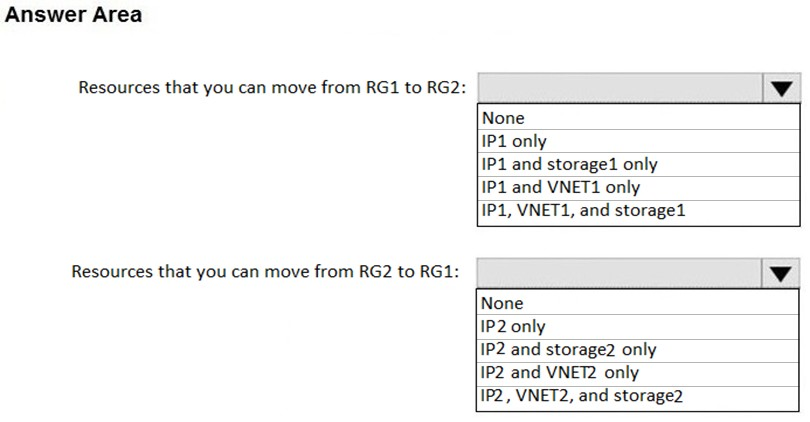
Answer : 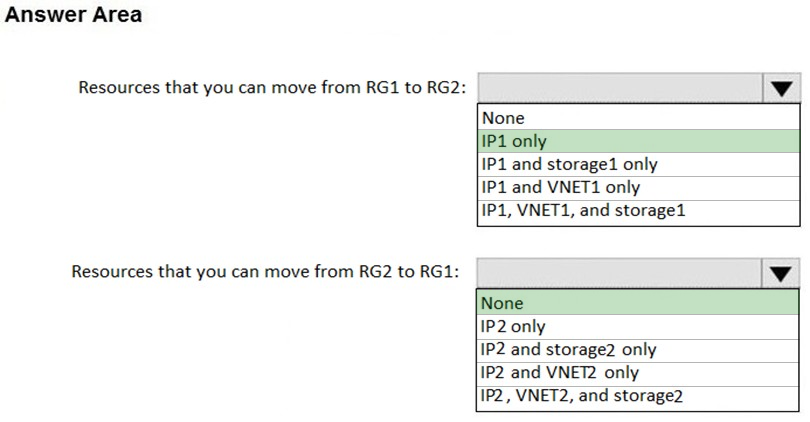
Reference:
https://docs.microsoft.com/en-us/azure/governance/blueprints/concepts/resource-locking
Question 5
HOTSPOT -
You have Azure subscriptions named Subscription1 and Subscription2.
Subscription1 has following resource groups:

RG1 includes a web app named App1 in the West Europe location.
Subscription2 contains the following resource groups:

For each of the following statements, select Yes if the statement is true. Otherwise, select No.
NOTE: Each correct selection is worth one point.
Hot Area:
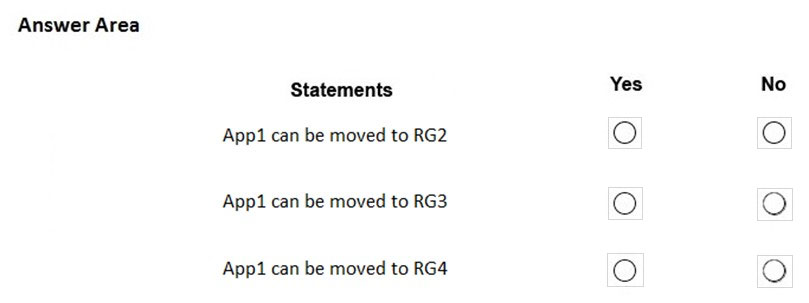
Answer : 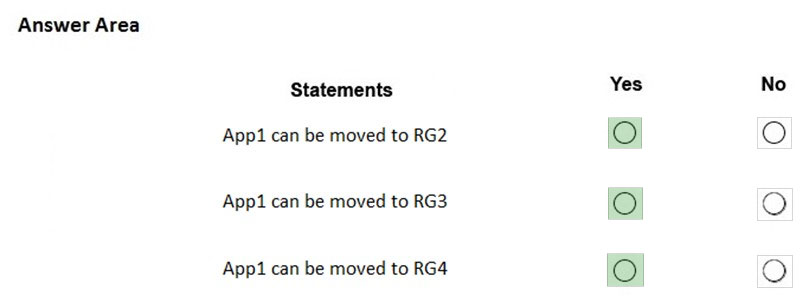
Reference:
https://docs.microsoft.com/en-us/azure/azure-resource-manager/management/move-limitations/app-service-move-limitations
Question 6
You have an Azure subscription named Subscription1 that contains a virtual network named VNet1. VNet1 is in a resource group named RG1.
Subscription1 has a user named User1. User1 has the following roles:
-> Reader
-> Security Admin
-> Security Reader
You need to ensure that User1 can assign the Reader role for VNet1 to other users.
What should you do?
- A. Assign User1 the Network Contributor role for RG1.
- B. Assign User1 the User Access Administrator role for VNet1.
- C. Remove User1 from the Security Reader and Reader roles for Subscription1.
- D. Remove User1 from the Security Reader and Reader roles for Subscription1. Assign User1 the Contributor role for Subscription1.
Answer : B
Explanation:
The User Access Administrator role allows you to manage user access to Azure resources.
Reference:
https://docs.microsoft.com/en-us/azure/role-based-access-control/built-in-roles#user-access-administrator
Question 7
HOTSPOT -
You have the Azure management groups shown in the following table.

You add Azure subscriptions to the management groups as shown in the following table.

You create the Azure policies shown in the following table.

For each of the following statements, select Yes if the statement is true. Otherwise, select No.
NOTE: Each correct selection is worth one point.
Hot Area:
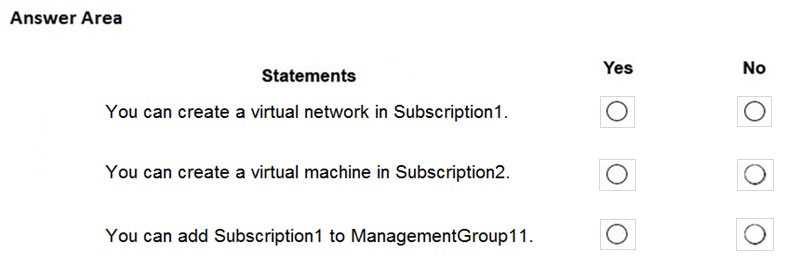
Answer : 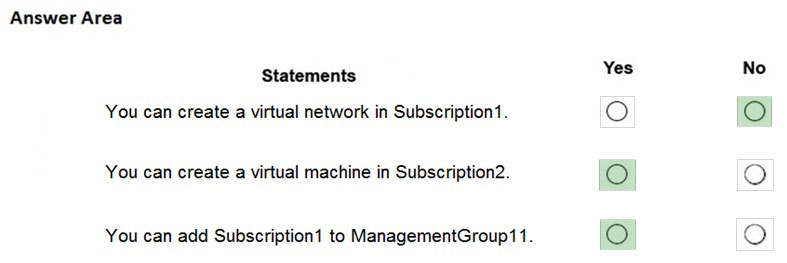
Explanation:
Box 1: No -
Virtual networks are not allowed at the root and is inherited. Deny overrides allowed.
Box 2: Yes -
Virtual Machines can be created on a Management Group provided the user has the required RBAC permissions.
Box 3: Yes -
Subscriptions can be moved between Management Groups provided the user has the required RBAC permissions.
Reference:
https://docs.microsoft.com/en-us/azure/governance/management-groups/overview https://docs.microsoft.com/en-us/azure/governance/management-groups/manage#moving-management-groups-and-subscriptions
Question 8
You have an Azure subscription named Subscription1 that contains an Azure Log Analytics workspace named Workspace1.
You need to view the error events from a table named Event.
Which query should you run in Workspace1?
- A. Event | where EventType is "error"
- B. Event | search "error"
- C. select * from Event where EventType == "error"
- D. Get-Event Event | where {$_.EventType -eq "error"}
Answer : B
Reference:
https://docs.microsoft.com/en-us/azure/azure-monitor/log-query/get-started-queries
Manage Azure subscriptions and resources
Question 9
Case study -
This is a case study. Case studies are not timed separately. You can use as much exam time as you would like to complete each case. However, there may be additional case studies and sections on this exam. You must manage your time to ensure that you are able to complete all questions included on this exam in the time provided.
To answer the questions included in a case study, you will need to reference information that is provided in the case study. Case studies might contain exhibits and other resources that provide more information about the scenario that is described in the case study. Each question is independent of the other questions in this case study.
At the end of this case study, a review screen will appear. This screen allows you to review your answers and to make changes before you move to the next section of the exam. After you begin a new section, you cannot return to this section.
To start the case study -
To display the first question in this case study, click the Next button. Use the buttons in the left pane to explore the content of the case study before you answer the questions. Clicking these buttons displays information such as business requirements, existing environment, and problem statements. If the case study has an All Information tab, note that the information displayed is identical to the information displayed on the subsequent tabs. When you are ready to answer a question, click the Question button to return to the question.
Overview -
Humongous Insurance is an insurance company that has three offices in Miami, Tokyo and Bangkok. Each office has 5,000 users.
Existing Environment -
Active Directory Environment -
Humongous Insurance has a single-domain Active Directory forest named humongousinsurance.com. The functional level of the forest is Windows Server 2012.
You recently provisioned an Azure Active Directory (Azure AD) tenant.
Network Infrastructure -
Each office has a local data center that contains all the servers for that office. Each office has a dedicated connection to the Internet.
Each office has several link load balancers that provide access to the servers.
Active Directory Issue -
Several users in humongousinsurance.com have UPNs that contain special characters.
You suspect that some of the characters are unsupported in Azure AD.
Licensing Issue -
You attempt to assign a license in Azure to several users and receive the following error message: "Licenses not assigned. License assignment failed for one user."
You verify that the Azure subscription has the available licenses.
Requirements -
Planned Changes -
Humongous Insurance plans to open a new office in Paris. The Paris office will contain 1,000 users who will be hired during the next 12 months. All the resources used by the Paris office users will be hosted in Azure.
Planned Azure AD Infrastructure -
The on-premises Active Directory domain will be synchronized to Azure AD.
All client computers in the Paris office will be joined to an Azure AD domain.
Planned Azure Networking Infrastructure
You plan to create the following networking resources in a resource group named All_Resources:
Default Azure system routes that will be the only routes used to route traffic
A virtual network named Paris-VNet that will contain two subnets named Subnet1 and Subnet2
A virtual network named ClientResources-VNet that will contain one subnet named ClientSubnet
A virtual network named AllOffices-VNet that will contain two subnets named Subnet3 and Subnet4
You plan to enable peering between Paris-VNet and AllOffices-VNet. You will enable the Use remote gateways setting for the Paris-VNet peerings.
You plan to create a private DNS zone named humongousinsurance.local and set the registration network to the ClientResources-VNet virtual network.
Planned Azure Computer Infrastructure
Each subnet will contain several virtual machines that will run either Windows Server 2012 R2, Windows Server 2016, or Red Hat Linux.
Department Requirements -
Humongous Insurance identifies the following requirements for the company's departments:
Web administrators will deploy Azure web apps for the marketing department. Each web app will be added to a separate resource group. The initial configuration of the web apps will be identical. The web administrators have permission to deploy web apps to resource groups.
During the testing phase, auditors in the finance department must be able to review all Azure costs from the past week.
Authentication Requirements -
Users in the Miami office must use Azure Active Directory Seamless Single Sign-on (Azure AD Seamless SSO) when accessing resources in Azure.
You need to resolve the licensing issue before you attempt to assign the license again.
What should you do?
- A. From the Groups blade, invite the user accounts to a new group.
- B. From the Profile blade, modify the usage location.
- C. From the Directory role blade, modify the directory role.
Answer : A
Explanation:
License cannot be assigned to a user without a usage location specified.
Scenario: Licensing Issue -
You attempt to assign a license in Azure to several users and receive the following error message: "Licenses not assigned. License agreement failed for one user."
You verify that the Azure subscription has the available licenses.
Question 10
Case study -
This is a case study. Case studies are not timed separately. You can use as much exam time as you would like to complete each case. However, there may be additional case studies and sections on this exam. You must manage your time to ensure that you are able to complete all questions included on this exam in the time provided.
To answer the questions included in a case study, you will need to reference information that is provided in the case study. Case studies might contain exhibits and other resources that provide more information about the scenario that is described in the case study. Each question is independent of the other questions in this case study.
At the end of this case study, a review screen will appear. This screen allows you to review your answers and to make changes before you move to the next section of the exam. After you begin a new section, you cannot return to this section.
To start the case study -
To display the first question in this case study, click the Next button. Use the buttons in the left pane to explore the content of the case study before you answer the questions. Clicking these buttons displays information such as business requirements, existing environment, and problem statements. If the case study has an All Information tab, note that the information displayed is identical to the information displayed on the subsequent tabs. When you are ready to answer a question, click the Question button to return to the question.
Overview -
Humongous Insurance is an insurance company that has three offices in Miami, Tokyo and Bangkok. Each office has 5,000 users.
Existing Environment -
Active Directory Environment -
Humongous Insurance has a single-domain Active Directory forest named humongousinsurance.com. The functional level of the forest is Windows Server 2012.
You recently provisioned an Azure Active Directory (Azure AD) tenant.
Network Infrastructure -
Each office has a local data center that contains all the servers for that office. Each office has a dedicated connection to the Internet.
Each office has several link load balancers that provide access to the servers.
Active Directory Issue -
Several users in humongousinsurance.com have UPNs that contain special characters.
You suspect that some of the characters are unsupported in Azure AD.
Licensing Issue -
You attempt to assign a license in Azure to several users and receive the following error message: "Licenses not assigned. License assignment failed for one user."
You verify that the Azure subscription has the available licenses.
Requirements -
Planned Changes -
Humongous Insurance plans to open a new office in Paris. The Paris office will contain 1,000 users who will be hired during the next 12 months. All the resources used by the Paris office users will be hosted in Azure.
Planned Azure AD Infrastructure -
The on-premises Active Directory domain will be synchronized to Azure AD.
All client computers in the Paris office will be joined to an Azure AD domain.
Planned Azure Networking Infrastructure
You plan to create the following networking resources in a resource group named All_Resources:
Default Azure system routes that will be the only routes used to route traffic
A virtual network named Paris-VNet that will contain two subnets named Subnet1 and Subnet2
A virtual network named ClientResources-VNet that will contain one subnet named ClientSubnet
A virtual network named AllOffices-VNet that will contain two subnets named Subnet3 and Subnet4
You plan to enable peering between Paris-VNet and AllOffices-VNet. You will enable the Use remote gateways setting for the Paris-VNet peerings.
You plan to create a private DNS zone named humongousinsurance.local and set the registration network to the ClientResources-VNet virtual network.
Planned Azure Computer Infrastructure
Each subnet will contain several virtual machines that will run either Windows Server 2012 R2, Windows Server 2016, or Red Hat Linux.
Department Requirements -
Humongous Insurance identifies the following requirements for the company's departments:
Web administrators will deploy Azure web apps for the marketing department. Each web app will be added to a separate resource group. The initial configuration of the web apps will be identical. The web administrators have permission to deploy web apps to resource groups.
During the testing phase, auditors in the finance department must be able to review all Azure costs from the past week.
Authentication Requirements -
Users in the Miami office must use Azure Active Directory Seamless Single Sign-on (Azure AD Seamless SSO) when accessing resources in Azure.
You need to resolve the Active Directory issue.
What should you do?
- A. Run the IdFix tool then use the Update action.
- B. From Active Directory Domains and Trusts, modify the list of UPN suffixes.
- C. From Azure AD Connect, modify the outbound synchronization rule.
- D. From Active Directory Users and Computers, select the user accounts, and then modify the UPN suffix value.
Answer : A
Explanation:
IdFix is used to perform discovery and remediation of identity objects and their attributes in an on-premises Active Directory environment in preparation for migration to Azure Active Directory. IdFix is intended for the Active Directory administrators responsible for directory synchronization with Azure Active Directory.
Scenario: Active Directory Issue
Several users in humongousinsurance.com have UPNs that contain special characters.
You suspect that some of the characters are unsupported in Azure AD.
References:
https://www.microsoft.com/en-us/download/details.aspx?id=36832
Question 11
Case study -
This is a case study. Case studies are not timed separately. You can use as much exam time as you would like to complete each case. However, there may be additional case studies and sections on this exam. You must manage your time to ensure that you are able to complete all questions included on this exam in the time provided.
To answer the questions included in a case study, you will need to reference information that is provided in the case study. Case studies might contain exhibits and other resources that provide more information about the scenario that is described in the case study. Each question is independent of the other questions in this case study.
At the end of this case study, a review screen will appear. This screen allows you to review your answers and to make changes before you move to the next section of the exam. After you begin a new section, you cannot return to this section.
To start the case study -
To display the first question in this case study, click the Next button. Use the buttons in the left pane to explore the content of the case study before you answer the questions. Clicking these buttons displays information such as business requirements, existing environment, and problem statements. If the case study has an All Information tab, note that the information displayed is identical to the information displayed on the subsequent tabs. When you are ready to answer a question, click the Question button to return to the question.
Overview -
Humongous Insurance is an insurance company that has three offices in Miami, Tokyo and Bangkok. Each office has 5,000 users.
Existing Environment -
Active Directory Environment -
Humongous Insurance has a single-domain Active Directory forest named humongousinsurance.com. The functional level of the forest is Windows Server 2012.
You recently provisioned an Azure Active Directory (Azure AD) tenant.
Network Infrastructure -
Each office has a local data center that contains all the servers for that office. Each office has a dedicated connection to the Internet.
Each office has several link load balancers that provide access to the servers.
Active Directory Issue -
Several users in humongousinsurance.com have UPNs that contain special characters.
You suspect that some of the characters are unsupported in Azure AD.
Licensing Issue -
You attempt to assign a license in Azure to several users and receive the following error message: "Licenses not assigned. License assignment failed for one user."
You verify that the Azure subscription has the available licenses.
Requirements -
Planned Changes -
Humongous Insurance plans to open a new office in Paris. The Paris office will contain 1,000 users who will be hired during the next 12 months. All the resources used by the Paris office users will be hosted in Azure.
Planned Azure AD Infrastructure -
The on-premises Active Directory domain will be synchronized to Azure AD.
All client computers in the Paris office will be joined to an Azure AD domain.
Planned Azure Networking Infrastructure
You plan to create the following networking resources in a resource group named All_Resources:
Default Azure system routes that will be the only routes used to route traffic
A virtual network named Paris-VNet that will contain two subnets named Subnet1 and Subnet2
A virtual network named ClientResources-VNet that will contain one subnet named ClientSubnet
A virtual network named AllOffices-VNet that will contain two subnets named Subnet3 and Subnet4
You plan to enable peering between Paris-VNet and AllOffices-VNet. You will enable the Use remote gateways setting for the Paris-VNet peerings.
You plan to create a private DNS zone named humongousinsurance.local and set the registration network to the ClientResources-VNet virtual network.
Planned Azure Computer Infrastructure
Each subnet will contain several virtual machines that will run either Windows Server 2012 R2, Windows Server 2016, or Red Hat Linux.
Department Requirements -
Humongous Insurance identifies the following requirements for the company's departments:
Web administrators will deploy Azure web apps for the marketing department. Each web app will be added to a separate resource group. The initial configuration of the web apps will be identical. The web administrators have permission to deploy web apps to resource groups.
During the testing phase, auditors in the finance department must be able to review all Azure costs from the past week.
Authentication Requirements -
Users in the Miami office must use Azure Active Directory Seamless Single Sign-on (Azure AD Seamless SSO) when accessing resources in Azure.
You need to define a custom domain name for Azure AD to support the planned infrastructure.
Which domain name should you use?
- A. ad.humongousinsurance.com
- B. humingousinsurance.onmicrosoft.com
- C. humongousinsurance.com
- D. humongousinsurance.local
Answer : C
Explanation:
Every Azure AD directory comes with an initial domain name in the form of domainname.onmicrosoft.com. The initial domain name cannot be changed or deleted, but you can add your corporate domain name to Azure AD as well. For example, your organization probably has other domain names used to do business and users who sign in using your corporate domain name. Adding custom domain names to Azure AD allows you to assign user names in the directory that are familiar to your users, such as "˜[email protected]."™ instead of 'alice@domain name.onmicrosoft.com'.
Scenario:
Network Infrastructure: Each office has a local data center that contains all the servers for that office. Each office has a dedicated connection to the Internet.
Humongous Insurance has a single-domain Active Directory forest named humongousinsurance.com
Planned Azure AD Infrastructure: The on-premises Active Directory domain will be synchronized to Azure AD.
References:
https://docs.microsoft.com/en-us/azure/active-directory/fundamentals/add-custom-domain
Question 12
Case study -
This is a case study. Case studies are not timed separately. You can use as much exam time as you would like to complete each case. However, there may be additional case studies and sections on this exam. You must manage your time to ensure that you are able to complete all questions included on this exam in the time provided.
To answer the questions included in a case study, you will need to reference information that is provided in the case study. Case studies might contain exhibits and other resources that provide more information about the scenario that is described in the case study. Each question is independent of the other questions in this case study.
At the end of this case study, a review screen will appear. This screen allows you to review your answers and to make changes before you move to the next section of the exam. After you begin a new section, you cannot return to this section.
To start the case study -
To display the first question in this case study, click the Next button. Use the buttons in the left pane to explore the content of the case study before you answer the questions. Clicking these buttons displays information such as business requirements, existing environment, and problem statements. If the case study has an All Information tab, note that the information displayed is identical to the information displayed on the subsequent tabs. When you are ready to answer a question, click the Question button to return to the question.
Overview -
Humongous Insurance is an insurance company that has three offices in Miami, Tokyo and Bangkok. Each office has 5,000 users.
Existing Environment -
Active Directory Environment -
Humongous Insurance has a single-domain Active Directory forest named humongousinsurance.com. The functional level of the forest is Windows Server 2012.
You recently provisioned an Azure Active Directory (Azure AD) tenant.
Network Infrastructure -
Each office has a local data center that contains all the servers for that office. Each office has a dedicated connection to the Internet.
Each office has several link load balancers that provide access to the servers.
Active Directory Issue -
Several users in humongousinsurance.com have UPNs that contain special characters.
You suspect that some of the characters are unsupported in Azure AD.
Licensing Issue -
You attempt to assign a license in Azure to several users and receive the following error message: "Licenses not assigned. License assignment failed for one user."
You verify that the Azure subscription has the available licenses.
Requirements -
Planned Changes -
Humongous Insurance plans to open a new office in Paris. The Paris office will contain 1,000 users who will be hired during the next 12 months. All the resources used by the Paris office users will be hosted in Azure.
Planned Azure AD Infrastructure -
The on-premises Active Directory domain will be synchronized to Azure AD.
All client computers in the Paris office will be joined to an Azure AD domain.
Planned Azure Networking Infrastructure
You plan to create the following networking resources in a resource group named All_Resources:
Default Azure system routes that will be the only routes used to route traffic
A virtual network named Paris-VNet that will contain two subnets named Subnet1 and Subnet2
A virtual network named ClientResources-VNet that will contain one subnet named ClientSubnet
A virtual network named AllOffices-VNet that will contain two subnets named Subnet3 and Subnet4
You plan to enable peering between Paris-VNet and AllOffices-VNet. You will enable the Use remote gateways setting for the Paris-VNet peerings.
You plan to create a private DNS zone named humongousinsurance.local and set the registration network to the ClientResources-VNet virtual network.
Planned Azure Computer Infrastructure
Each subnet will contain several virtual machines that will run either Windows Server 2012 R2, Windows Server 2016, or Red Hat Linux.
Department Requirements -
Humongous Insurance identifies the following requirements for the company's departments:
Web administrators will deploy Azure web apps for the marketing department. Each web app will be added to a separate resource group. The initial configuration of the web apps will be identical. The web administrators have permission to deploy web apps to resource groups.
During the testing phase, auditors in the finance department must be able to review all Azure costs from the past week.
Authentication Requirements -
Users in the Miami office must use Azure Active Directory Seamless Single Sign-on (Azure AD Seamless SSO) when accessing resources in Azure.
Which blade should you instruct the finance department auditors to use?
- A. Cost analysis
- B. Resource providers
- C. Payment methods
- D. Invoices
Answer : D
Explanation:
You can opt in and configure additional recipients to receive your Azure invoice in an email. This feature may not be available for certain subscriptions such as support offers, Enterprise Agreements, or Azure in Open.
1. Select your subscription from the Subscriptions page. Opt-in for each subscription you own. Click Invoices then Email my invoice.
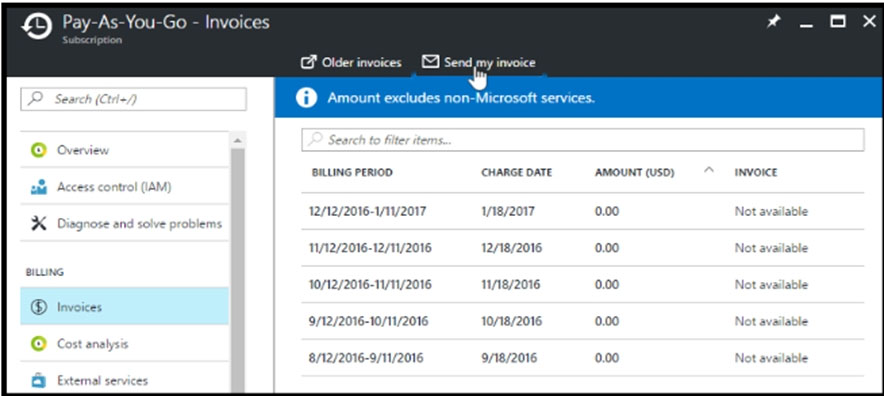
2. Click Opt in and accept the terms.
Scenario: During the testing phase, auditors in the finance department must be able to review all Azure costs from the past week.
Reference:
https://docs.microsoft.com/en-us/azure/billing/billing-download-azure-invoice-daily-usage-date
Implement and manage storage -
Question 13
HOTSPOT -
You have several Azure virtual machines on a virtual network named VNet1.
You configure an Azure Storage account as shown in the following exhibit.
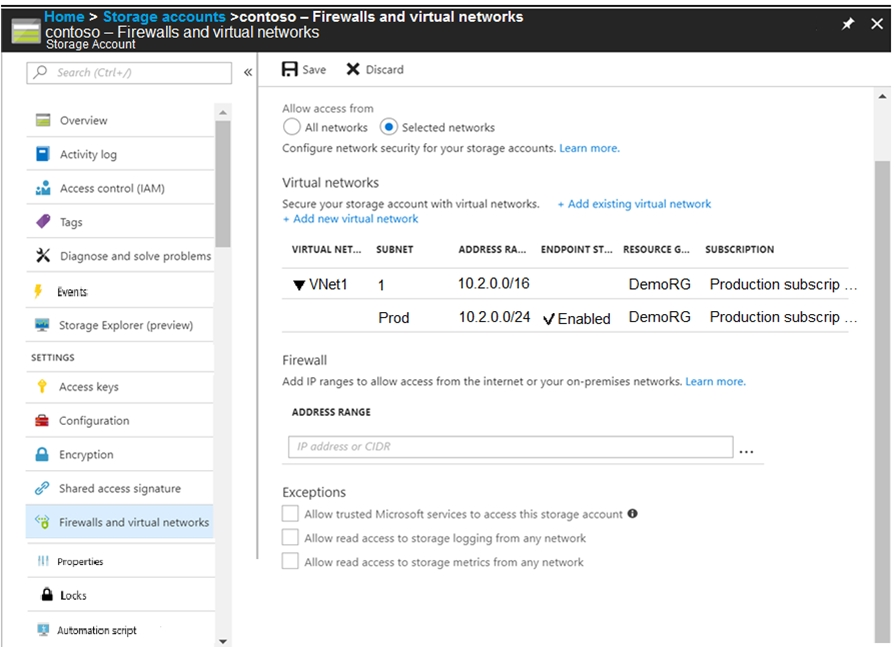
Use the drop-down menus to select the answer choice that completes each statement based on the information presented in the graphic.
NOTE: Each correct selection is worth one point.
Hot Area:
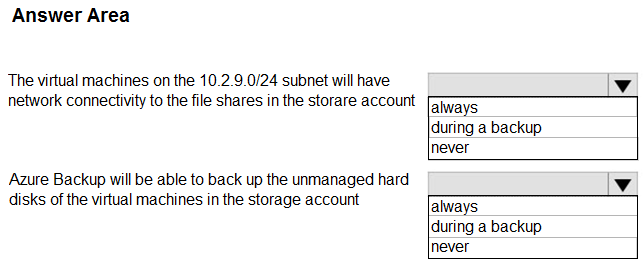
Answer : 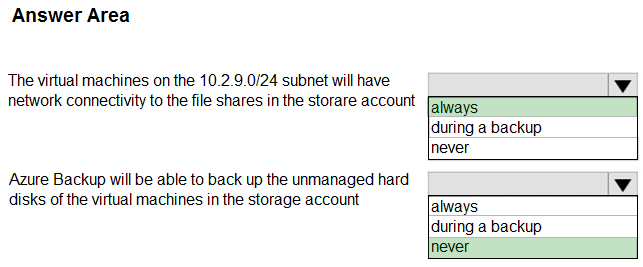
Explanation:
Box 1: always -
Endpoint status is enabled.
Box 2: Never -
After you configure firewall and virtual network settings for your storage account, select Allow trusted Microsoft services to access this storage account as an exception to enable Azure Backup service to access the network restricted storage account.
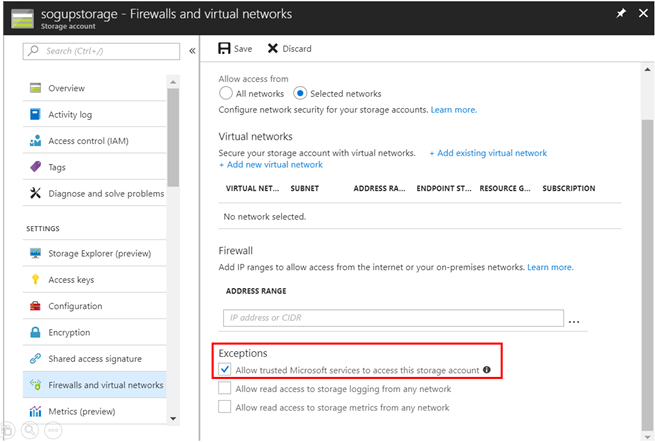
Reference:
https://docs.microsoft.com/en-us/azure/storage/files/storage-how-to-use-files-windows https://azure.microsoft.com/en-us/blog/azure-backup-now-supports-storage-accounts-secured-with-azure-storage-firewalls-and-virtual-networks/
Question 14
You have two Azure virtual machines named VM1 and VM2. You have two Recovery Services vaults named RSV1 and RSV2.
VM2 is protected by RSV1.
You need to use RSV2 to protect VM2.
What should you do first?
- A. From the VM2 blade, click Disaster recovery, click Replication settings, and then select RSV2 as the Recovery Services vault.
- B. From the RSV2 blade, click Backup. From the Backup blade, select the backup for the virtual machine, and then click Backup.
- C. From the RSV1 blade, click Backup Jobs and export the VM2 job.
- D. From the RSV1 blade, click Backup items and stop the VM2 backup.
Answer : A
Reference:
https://docs.microsoft.com/en-us/azure/backup/backup-azure-vms-first-look-arm
Question 15
HOTSPOT -
You plan to deploy 20 Azure virtual machines by using an Azure Resource Manager template. The virtual machines will run the latest version of Windows Server
2016 Datacenter by using an Azure Marketplace image.
You need to complete the storageProfile section of the template.
How should you complete the storageProfile section? To answer, select the appropriate options in the answer area.
NOTE: Each correct selection is worth one point.
Hot Area:
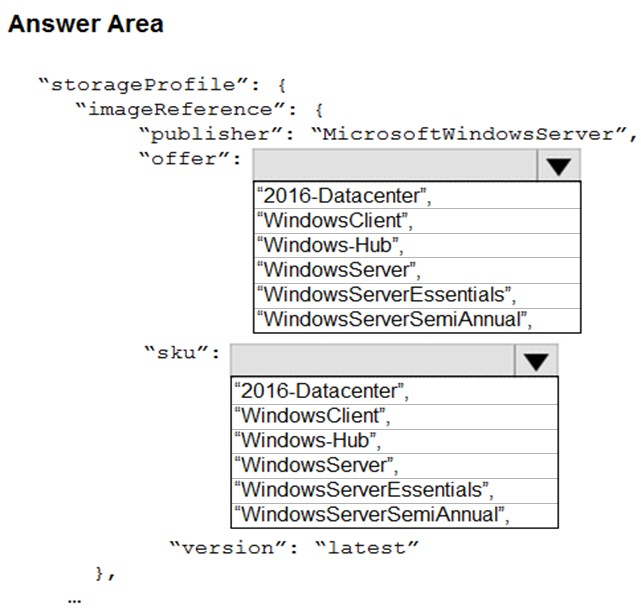
Answer : 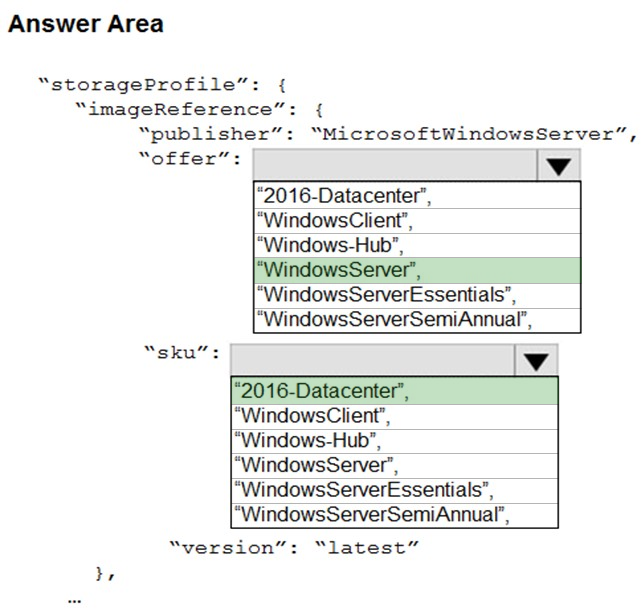
Explanation:
"¦
"storageProfile": {
"imageReference": {
"publisher": "MicrosoftWindowsServer",
"offer": "WindowsServer",
"sku": "2016-Datacenter",
"version": "latest"
},
"¦
Reference:
https://docs.microsoft.com/en-us/rest/api/compute/virtualmachines/createorupdate